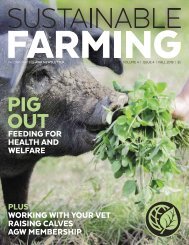A Greener World's Sustainable Farming Magazine V6 I1— Winter 2021
News: Egg Plant – The basics of keeping laying hens; AGW in India; Snakes on Farms; Vaccinations – A vital tool Opinion: At The Crossroads Cover feature: Laying Hens 101 Certification News: AGW India Technical: Staying Safe Technical: Snakes In The Grass Certification News: A New Year Meet the Farmer: Lison Du Nord in Ontario, Canada
News: Egg Plant – The basics of keeping laying hens; AGW in India; Snakes on Farms; Vaccinations – A vital tool
Opinion: At The Crossroads
Cover feature: Laying Hens 101
Certification News: AGW India
Technical: Staying Safe
Technical: Snakes In The Grass
Certification News: A New Year
Meet the Farmer: Lison Du Nord in Ontario, Canada
- No tags were found...
You also want an ePaper? Increase the reach of your titles
YUMPU automatically turns print PDFs into web optimized ePapers that Google loves.
LAYING HENS 101
Thinking of setting up a new AGW-certified laying hen
operation? Frank Morison looks at the basics
Pasture-raised eggs can provide a useful income
stream to an existing farming business. But as
with any new venture, it is essential to ask yourself
some important questions before buying in your
first chicks.
Do I have the time and additional resources to
accomplish this task? Can I afford the initial outlay?
What are my costs of production? Do I have a
viable local market, such as a major metropolitan
area or popular farmers’ market? Will local stores
or restaurants take my eggs? What makes my farm
and eggs different from local competition?
Only you can answer these questions. Do not
rush: think it through carefully, as these questions
may lead to other issues you might not have
considered.
Remember: the number of birds you plan to
keep will not only dictate the number of eggs
you will have to sell, but also things like space
requirements for brooding, housing and range
area, perch provision, feed supplies and so on.
Make sure you do your homework first!
Choosing the breed
Most small-scale farmers choose traditional-type
breeds for their good ranging and foraging abilities.
Here are some commonly used breeds for
pasture-based production:
Araucana: 250 eggs of blue or green shell color
per cycle. Can be flighty. Some farmers add
the colored eggs of these birds into a carton
to make them stand out from competition.
Barred Rock: 250–260 eggs of brown shell
color per cycle. Calm bird, great disposition.
Delaware: 250–260 eggs of brown shell color
per cycle. Calm bird, hardy for cold regions.
The Delaware breed was used to start the
modern broiler industry.
Rhode Island Red: 250-260 eggs of brown
shell color per cycle. Friendly and calm.
White Leghorn: 280 eggs of white shell color
per cycle. Nervous and flighty.
Note: AGW does not endorse any specific breed.
Lay rates will vary depending on strain and
hatchery.
Sourcing birds
AGW standards require you to source chicks or
point-of-lay (POL) pullets from an AGW-certified
laying hen/breeder farm. If there is no suitable
supplier near you, you can order chicks from any
hatchery or farm as long as the birds are placed
on your farm by 36 hours of age. Note: you can
only source POL pullets from AGW-certified
laying hen/breeder farms.
If your hatchery is within driving distance it’s
well worth picking up the chicks instead of having
them mailed. The faster you get the chicks on the
ground eating and drinking, the better overall
results you will have.
Speak with a local veterinarian or extension
agent to discuss potential vaccination against
diseases in your area. Some hatcheries offer
vaccinations when you order.
Brooding
It is possible to brood and raise a small number
of chicks in a garage or a spare outbuilding. But
brooding is a critical time for the young chick and
any brooding area must be predator proof with
access to water, electricity and a heat source to
keep chicks warm. You will need to provide a
minimum of 0.25 sq. ft. brooding space per chick,
increasing the area appropriately as the birds grow.
You will also need to provide training perches
made from natural tree limbs or lumber for young
pullets from 10 days of age through to point of
lay. Remember that AGW’s laying hen standards
require chicks “to have access to forage by seven
days of age.” Some farmers place a piece of sod
in the brood chamber to help the chicks become
more accustomed to foraging.
Housing
After brooding, chicks will need suitable housing
with access to pasture. There are many different
types of stationary and mobile housing kits
available to purchase. If you’re looking to save
costs, you can build your own coop from scratch
(plenty of designs are available), while it is certainly
possible to modify an old farm wagon, camper
or mobile home into a mobile coop or roost, and
construct your own nesting and perching systems.
Likewise, an existing barn with extra space will
work well. Just like the brooding area, you will
need water and electricity and possibly a heat
source, depending on where you farm.
There are pros and cons to using mobile and
stationary structures.
MIKE SUAREZ
8 • SUSTAINABLE FARMING • WINTER 2021
WINTER 2021 • SUSTAINABLE FARMING • 9




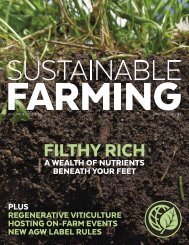
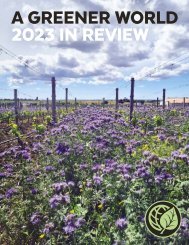
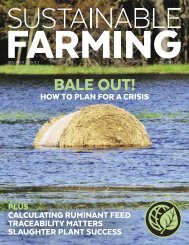

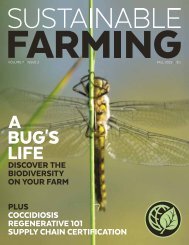
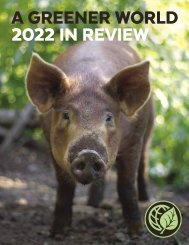
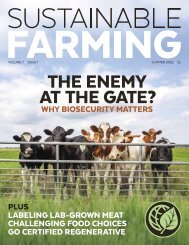
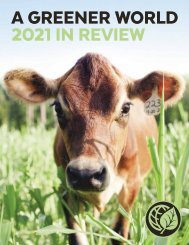
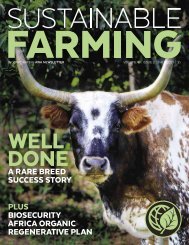



![SF Magazine V5 I1 -- Winter-Spring 2020 [SCREEN ONLY]](https://img.yumpu.com/63122871/1/190x245/sf-magazine-v5-i1-winter-spring-2020-screen-only.jpg?quality=85)
